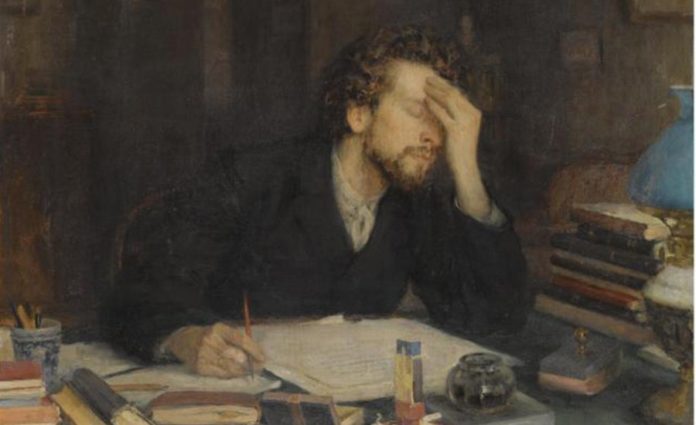How to Write a Good Artist Statement
By Loney Abrams
Writing about art is hard. Writing about art that you made can be even harder. We hear artists say, “If I knew how to describe my work in words, I’d be a writer, not an artist.” While this may be true, what’s “truer” is the fact that at some point, you as an artist will be asked to write an artist statement—and whether or not it is good, will matter. So, what makes an artist statement “good”? Whether you’re applying for a residency or grant, or you just want to perfect your elevator pitch, here are a handful of things not to include in your artist statement, plus a few tips to make the process a little less excruciating.
1. Your Artist Statement Is Not “A Piece”
Resist the temptation to use this as an opportunity to write a poem or subvert the “institution of the artist statement.” We get it; you’re an artist. We really do just genuinely want to know what your art is about. Please tell us.
2. Oh, You Loved Art as a Child? Join the Club
The worst way to start an artist statement is with the following words: “Every since I was a little girl, I’ve always loved making art.” Unless you were literally raised by wolves or grew up in a hermetically sealed suite a la Bubble Boy, this is not interesting information. Most kids love art, and regardless, having a long love affair with your craft doesn’t mean much—it’s what you have to show for it that counts. There is really no need to explain when you became interested in art.
3. Avoid These Words:
Juxtapose
Humanity
Human condition
Concerns
Chaos
Uncanny (unless it truly, truly is uncanny. Look up the definition.)
Notions
Speculative
Explores
Rupture
Troubled
Liminal
Controversial (unless it actually sparked controversy.)
Deconstructs
4. Just Use Fewer Words in General
Don’t convolute your sentences by beating around the bush. For instance: “My art practice is concerned with exploring notions of gender” really means, “My art is about gender.” Or, “I’m interested in investigating ideas and concepts surrounding notions of race” becomes “I investigate race.” Be specific and don’t use vague words that keep you from getting to the point.
5. If Your Work Is About You, Why Should We Care?
If you’re making art about your personal experience, fine. But the question you have to ask yourself is, “Why is my personal experience relevant to anyone but me?” What does your experience say about the world you live in? What can people learn from your story that might be useful to them? Use your experience to illustrate some larger issue, topic, culture, or idea that others can relate to or learn from.
6. Find Help
Not everyone is a good writer, and that’s totally okay. You shouldn’t need to be able to recite the Chicago Manual of Style verbatim to write a good artist statement. But don’t let your lackluster writing skills be an excuse for a sloppy statement. Find a wordsmith, buy them a beer, and ask them to help you edit your text. Not only will a poorly written statement make your ideas harder to understand, but grammatical errors could also come off as evidence of apathy and irreverence towards whatever opportunity you’re vying for.
7. Don’t Say Your Work Is Interesting—We’ll Be the Judge of That
Remember what your middle school English teacher told you—show, don’t tell. Describing your work as meaningful, captivating, groundbreaking, beautiful, or interesting doesn’t tell your reader anything about what your work actually is. (Plus, it comes off as a little cocky.) Instead, write about your work in a way that shows how it’s interesting.
8. Don’t Reference Deleuze Unless You Absolutely Have To
In general, it’s probably best to avoid relying on the ideas of other people to prop up your work. But if you really must reference a philosopher, critic, or theorist, make sure to write a very brief (could be five words) description of who that person is. Don’t assume everyone who reads your statement had the same liberal arts education you did. In terms of referencing other artists: if your work intentionally and deliberately references other artists, and these references are integral to the meaning of your work, by all means, name the artists you reference. Otherwise, do not compare yourself to other artists, e.g., “Like Picasso, I paint…”
9. Know What “International Art English” Is, And Void Using It
In 2012, Alix Rule and David Levine brilliantly and hilariously wrote about what they called “International Art English”: the “the curious lexical, grammatical, and stylistic features” too commonly found in art-world press releases. Here is a tiny excerpt, but do yourself a favor and read the entire thing:
“IAE has a distinctive lexicon: aporia, radically, space, proposition, biopolitical, tension, transversal, autonomy. An artist’s work inevitably interrogates, questions, encodes, transforms, subverts, imbricates, displaces—though often it doesn’t do these things so much as it serves to, functions to, or seems to (or might seem to) do these things. IAE rebukes English for its lack of nouns: Visual becomes visuality, global becomes globality, potential becomes potentiality, experience becomes… experiencability.”
10. Write About the Most Interesting Aspects of Your Work (Not All Aspects Are Interesting)
Explaining your process can reveal something about your work that isn’t immediately known by just looking at it. If this is the case, explain away. But for most artists, this play-by-play account just isn’t necessary. For instance, if you’re a painter, there is really no need to mention that you begin your day by priming your canvases, or that your artwork always begins with “an idea” or “a sketch.” Figure out what makes your work unlike other people’s and focus on that. For some artists, that is their process, for others it might be their research methods, or concepts, or relationship to art history, etc.
11. Keep It Short and Sweet
If you’re applying for an opportunity like an artist residency, art school, or a grant, chances are your artist statement will be one of many. Keep in mind that the person reading your statement may only have time to skim the first few lines, so if you can succinctly describe your practice in four sentences, do it. Less is more. You don’t want the success of your application to rely on whether or not your panelist can read 2,000 words in 60 seconds.
12. Your Love for Making Art Doesn’t Justify its Worth
Please, please, please don’t write about how much you love painting, or how fun it is to be in the studio, or how ceramics is a form of therapy. Don’t get it wrong—we’re very happy for you if you feel these ways, and we understand that working creatively can be a very uplifting and joyful process. But here’s the thing: your experience of making your art in no way influences our experience of looking at it. This may seem counter-intuitive, but an artist statement is not about you, the artist; its about your work, the art.
13. Talk It Out
If you’re having writers block, don’t give up. Download a voice recording app on your phone and record yourself talking about your work out loud to a friend (or your cat.) After you transcribe your speech and edit out the likes and ums, you might be surprised with how good it sounds. And if not, at least you’ll have something down on the page that you can work from. Text that is conversational and seemingly effortless is easier and more fun to read that text that seems like it was painstakingly laborious to write.
14. Obviously, Describe Your Work
If someone was standing in front of your art, what questions might they ask you? What could you tell them that would give them a richer, more informed viewing experience? Write about your work in a way that will add something to the viewing experience, not just summarize it. If you’re having trouble getting the juices flowing, here are a few questions you can answer to get you started (just remember, you don’t need to address all of these in your statement.):
Why did you make the art that you made?
What does it say about the world?
What does it help people understand?
What does it look like?
What did you make it out of and how did you make it?
How does it address the history of its medium?
What sort of culture, topic, or issue does it describe?
What do you expect your audience to gain from it?







